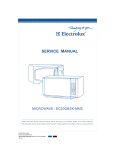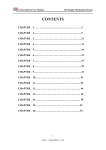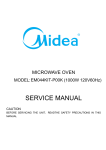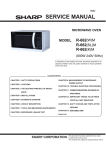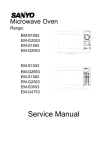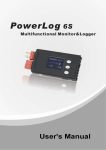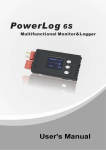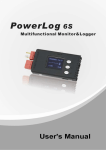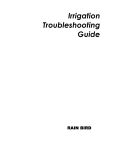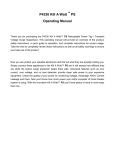Download SERVICE MANUAL
Transcript
MICROWAVE OVEN MODEL: EC028ACN-S00A (1000W 120V6 0Hz) SERVICE MANUAL CAUTION BEFORE SERVICING THE UNIT,READTHE SAFETY PRECAUTIONS IN THIS MANUAL SAFETY PRECAUTIONS This device is to be serviced only by properly qualified service personnel. Consult the service manual for proper service procedures to assure continued safety operation and for precautions to be taken to avoid possible exposure to excessive microwave energy. PRECAUTIONS TO BE OBSERVED BEFORE AND DURING SERVICING TO AVOID POSSIBLE EXPOSURE TO EXCESSIVE MICROWAVE ENERGY A) Do not operate or allow the oven to be operated with the door open. B) Make the following safety checks on all ovens to be serviced before activating the magnetron or other microwave source, and make repairs as necessary; (1) interlock operation, (2) proper door closing, (3) seal and sealing surfaces (arcing, wear, and other damage), (4) damage to or loosening of hinges and latches, (5) evidence of dropping or abuse. C) Before turning on microwave power for any service test or inspection within the microwave generating compartments, check the magnetron, wave guide or transmission line, and cavity for proper alignment, integrity, and connections. D) Any defective or misadjusted components in the interlock, monitor, door seal, and microwave generation and transmission systems shall be repaired, replaced, or adjusted by procedures described in this manual before the oven is released to the owner. E) A microwave leakage check should be performed on each oven prior to release to the owner. CAUTION MICROWAVE RADIATION DO NOT BECOME EXPOSED TO RADIATION FROM THE MICROWAVE GENERATOR OR OTHER PARTS CONDUCTING MICROWAVE ENERGY. TABLE OF CONTENTS (page) SAFETY PRECAUTIONS---------------------------------------------------------Inside front cover CAUTIONS------------------------------------------------------------------------------------------------1-1 THE HEATING PRINCIPLE OF MICROWAVE--------------------------------------------------2-1 INSTALLATIONS----------------------------------------------------------------------------------------3-1 OPERATING INSTRUCTIONS----------------------------------------------------------------------4-1 SCHEMATIC DIAGRAM--------------------------------------------------------------------------4-1 CIRCUIT DESCRIPTION-------------------------------------------------------------------------4-2 SERVICE INFORMATION-----------------------------------------------------------------------------5-1 TOOLS AND MEASURING INSTRUMENTS------------------------------------------------5-1 MICROWAVE LEAKAGE TEST----------------------------------------------------------------5-2 MEASUREMENT OF MICROWAVE POWER OUTPUT---------------------------------5-3 TROUBLE SHOOTING PROCEDURES------------------------------------------------------5-4 COMMON BREAKDOWN AND MEANS OF REPAIRING-------------------------------5-8 IMPORTANT THINGS TO DO PRIOR TO CRITICAL PART SERVICING-------------------------5-9 SAFETY CHECKS AND TESTS AFTER SERVING--------------------------------------5-10 EXPLODED VIEW---------------------------------------------------------------------------------------6-1 REPLACEMENT PARTS LIST-----------------------------------------------------------------------6-1 CAUTIONS Unlike other appliances, the microwave oven is high-voltage and high-current equipment. Though it is free from danger in ordinary use, extreme care should be taken during repair. MICROWAVE RADIATION Personnel should not be exposed to the microwave energy which may radiate from the magnetron or other microwave generating device if it is improperly used or connection. • DO NOT operate on a 2-wire extension cord during All input and output microwave connections, repair and use. waveguide, flange and gasket must be secure • NEVER TOUCH any oven components or wiring during never operate the device without a microwave operation. energy absorbing load attached. • BEFORE TOUCHING any parts of the oven, always remove the power plug from the outlet. • For about 30 seconds after the oven stops, an electric Never look into an open waveguide or antenna while the device is energized. charge remains in the high voltage capacitor. When replacing or checking, you must discharge the high • Proper operation of the microwave oven voltage capacitor by shorting across the two terminals requires that with an insulated screwdriver. the magnetron be assembled to the waveguide and cavity. Never operate the magnetron unless it is properly installed. • Be sure that the magnetron gasket is properly installed around the dome of the tube whenever installing the magnetron. • Remove your watches whenever working close to or replacing the Magnetron. • DO NOT touch any parts of the control panel circuit. A resulting static electric discharge may damage this P.C.B. • NEVER operate the oven with no load. • NEVER injure the door seal and front plate of the oven cavity. • NEVER put iron tools on the magnetron. • NEVER put anything into the latch hole and the interlock switches area.` 1-1 THE OVEN IS TO BE SERVICED ONLY BY PROPERLY QUALIFIED SERVICE PERSONNEL. THE HEATING PRINCIPLE OF MICROWAVE Microwave is one kind of radio wave whose wave length is very short, frequency is very high. Therefore, it is called ultrahigh frequency electromagnetic wave. Microwave can heat food mainly result in the mutual affect of the food in the microwave field and microwave field itself. Under the affect of microwave field, the thermal effect mechanism produced from the mutual affect of the microwave and the food includes two aspects: One is Dielectric loss of polar molecule, the other is conductive loss of ion. Usually, food is constitute of organism (plant and animal).The organism is formed by all kinds of polar water molecule, polar protein molecule, and all sorts of salt ion. The center of gravity of the positive and negative charge in the molecule is not coincide. In normal condition, the molecule is in irregular order due to its thermal action, thus the food do not appear polarity (FIG.11a).Under the action of outer electric field, the positive end of the polar molecule trend to the negative electric field, the negative end of polar molecule trend to the positive electric field, and somewhat arrange in order through the direction of the electric field(FIG.1-1c).This phenomenon usually be called “TORQUE POLARITY”. When the outer electric field apply for the opposite polarity, the polar molecule then arrange an opposite direction order accordingly (FIG.1-1b).If the direction of the outer electric field changed repeatedly, the polar molecule would repeatedly sway accordingly. During the swaying, it understands that the polar molecule would produce heat due to somewhat similar friction among them. When the electric field is applied for ultrahigh frequent microwave field from the outside, its direction would change tens billion times per second, so do the molecule. This kind of molecule swaying producing similar frictional heat from the interference and block of the action strength among the molecule, and changed to microscopic microwave heating. Microwave heating not only concerned the nature of the matter itself, but also closely connected with the electric field strength and frequency. When the frequency is low, the molecule swaying rate and the acute degree of the mutual friction among the molecule is low, and would produce much heat. When the frequency is too high, as the swing of the polar molecule is with rotating inertia, it made the swing do not in line with the changing rhythm of the electric field because of the friction drag, thus, actually lowed the polar molecule swaying speed. The friction dragging degree is concerning about the magneto electric wave frequency, polar molecule shape, and the matter’s sticky degree. To different matter’s molecule, there are different special frequency zone. Those ado absorb microwave energy from these zone are most capable to turn microwave energy to heat energy. Apart from the above said action, there is another action which is electric ion under the action of microwave field, act fiercely accompanied with the acceleration of electric field. The positive ion transfer to the negative polarity of the field while the negative ion do opposite. Accompanying with the changing electric field, the electric ion changing accordingly. During the transferring, heat produced with the crash among the ion. This kind of action take the main effect to those microwave heating of high salt molecule. No matter it is the polar molecule swaying or the ion transferring, they both are turning the microwave energy which the heating matter got from the microwave field to hear energy. From the analysis of theory, we can draw such a conclusion that the power which a unit of volume matter absorbed from the microwave field as the following formula: Pa=K·E· F·Er·tgδ Pa Stands for the power the heated matter absorbed from the microwave field. K Stands for a constant E Stand for microwave field strength F Stands for the microwave frequency. Er Stands for relative dielectric constant of the heated matter. tgδStands for loss angle tangent of the heated matter 2-1 INSTALLATIONS BEFORE YOU BEGIN, READ THE FOLLOWING INSTRUCTIONS COMPLETELY INSTALLING EARTHING INSTRUCTIONS 1. Empty the microwave oven and clean inside it with a soft, damp cloth. Check for damage such as This microwave oven is designed to be used in a fully misaligned door, damage around the door or dents earthed condition. inside the cavity or on the exterior. It is imperative, therefore, to make sure it is properly earthed before servicing 2. Put the oven on a counter, table, or shelf that is WARNING- strong enough to hold the oven and the food and utensils you put in it. (The control panel side of the THIS APPLIANCE oven is the heavy side. Use care when handling.) MUST BE EARTHED 3. Do not block the vent and the air intake openings. IMPORTANT Blocking vent or air intake openings can cause damage to the oven and poor cooking results. Make sure the microwave oven legs are in place to The wires in this mains lead are colored in ensure proper air flow. accordance with the following code: Green-and-yellow: Earth 4. The oven should not be installed in any area where Blue: Neutral heat and steam are generated, because they may Brown: Live damage the electronic or mechanical parts of the unit. As the colors of the wires in the mains lead of this Do not install the oven next to a conventional appliance may not correspond with the colored surface unit or above a conventional wall oven. markings identifying the terminals in your plug, proceed as follows. 5. Use microwave oven in an ambient temperature less than 104°F(40°C). The wire which is colored green-and-yellow must be connected to the terminal in the plug which is marked 6. Place the microwave oven on a sturdy and flat surface at least 10 cm(4 inches) from the wall. 7. Place the microwave oven as far away as possible with the letter E or by the earth symbol ( ) or colored green or green-and-yellow. from TV, RADIO, COMPUTER, etc., to prevent The wire which is colored blue must be connected to interference. the terminal in the plug which is marked with the letter N or colored black. The wire which is colored brown must be connected to the terminal in the plug which is marked with the letter L or colored red. 3-1 SCHEMATIC DIAGRAM MAGNETRON PRIMARY INTERLOCK N N GN FM WH GE OL YW TM CM YW BL BL INTERLOCK BR L CONVECTION HEATER WH(BR) FUSE L RD H.V. CAPACITOR RD BL H.V. DIODE RD BL WH WH BL HIGH VOLTAGE TRANSFOMER CN1 BL YW WH 1 3 5 7 FAN RELAY CONVECTION HEATER RELAY TOP HEATER RELAY POWER RELAY SWITCH CN2 CN3 THERMISTOR BL SECONDARY INTERLOCK RD MOTOR RELAY 2 N BK(BR) RD 1 L RD RD FILTER ASS'Y MONITOR SWITCH SINGLE PHASE ONLY RD HEATER THERMAL CUT-OUT RD RD BK RD HEATER THERMOSTAT TOP HEATER POWER SUPPLY : BK RD BR BR THERMAL CUT-OUT MAGNETRON SWITCH(UPPER) L.V. TRANSFORMER BL CONTROL P.W.B. ASS'Y [ CONDITION ] NOTE : DOOR : CLOSED OL : OVEN LAMP BK : BLACK COOK FM : FAN MOTOR RD : RED BL : BLUE BR : BROWN CM : CONVECTION FAN MOTOR WH : WHITE GN : GREEN YW : YELLOW GE : GREEN/YELLOW : OFF TM : TRAY MOTOR BR : BROWN CIRCUIT DESCRIPTION GENERAL DETAILS power of microwave oven as POWER LEVEL. • The low voltage transformer supplies the necessary voltage to the micom controller when power cord is plugged in. • When the door is closed, the primary switch is ON, the secondary switch is ON, and the monitor switch opens (contact COM and NO). WHEN THE DOOR IS OPENED DURING COOKING • Both the primary switch and relay 2 are cut off primary winding voltage of the high voltage transformer. • ON-OFF of relay 2 is coupled electrically with opening and closing of the secondary switch. • When the door is opened, the secondary switch is opened and when the door is closed, the secondary switch is closed. • The cooking time stops counting down. • Relay stops functioning. • As the door is opened, if the contact of primary switch and relay 2 and/or secondary switch fails to open, the fuse opens due to the large current surge caused by the monitor switch activation, which in turn stops magnetron oscillation. WHEN SELECTING COOKING POWER LEVEL AND TIME • The micom controller memorizes the function you set. • The time you set appears in the display window. • Each indicator light turns on to indicate that the stage has been set. WHEN TOUCHING THE START PAD • The coil of the relay is energized by the micom controller. • Power input is supplied to the high voltage transformer through the fuse to the primary switch and relay 2. • Turntable rotates. FUSE FUSE PRIMARY SWITCH L PRIMARY SWITCH TRANSFORMER MONITOR SWITCH L N MONITOR SWITCH TRANSFORMER N SECONDARY SWITCH RELAY 2 MICOM CONTROLLER RELAY 2 SECONDARY SWITCH MICOM CONTROLLER WHEN TOUCHING THE START KEY WITH THE GRILL COOKING FUNCTION SELECTED • The fan motor rotates and cools the magnetron by blowing the air (coming from the intake on the baseplate) • The air is also directed into the oven to exhaust the vapor in the oven through the upper plate. • Cooking time starts counting down. • 3.2 volts AC is generated from the filament winding of the high voltage transformer. This 3.2 volts is applied to the magnetron to heat the magnetron filament through two noise preventing choke coils. • A high voltage of approximately 2100 volts AC is generated in the secondary of the high voltage transformer which is increased by the action of the high voltage diode and charging of the high voltage capacitor. • The negative 4,000 Volts DC is applied to the filament of the magnetron. • The contacts of the primary switch and the secondary switch close the circuit. • A.C.voltage is applied to the grill heater through grill thermostat as shown by the solid line. GRILL THERMOSTAT TOP HEATER RELAY L L G -Y N E GRILL HEATER N • Turntable rotates. • The fan motor rotates. • The air is also directed into the oven to exhaust the vapor in the oven through the base plate and upper plate. WHEN THE OVEN IS SET AT ANY LEVEL EXCEPT MAXIMUM. • The micom controller controls the ON-OFF time of relay 2 by the applied signal to vary the average output 4-2 SERVICE INFORMATION TOOLS AND MEASURING INSTRUMENTS NECESSARY TOOLS Tools normally used for TV servicing are sufficient. NECESSARY MEASURING INSTRUMENTS Standard tools are listed below. • TESTER(VOLTS-DC, AC., Ohmmeter) • Diagonal pliers • Microwave survey meter • Long nose pliers - Holaday HI-1710(A) • Phillips screwdriver - Narda 8100 • Flat blade screwdriver 8200 • Wrench (size 5mm) • Inch scale • Nutdriver (size 5mm) • 600 cc non conductive material beaker (glass or • Adjustable wrench plastic), inside diameter: approx. 8.5 cm(31/2 in.) • Soldering iron • Cylindrical and made of borosilicate glass vessel. • Solder max. thickness: 3 mm • Vinyl insulation tape outside diameter: approx. 190mm • Polishing cloth height: approx. 90mm • Glass thermometer: 100°C or 212°F (1 deg scale) MICROWAVE LEAKAGE TEST • Be sure to check microwave leakage prior to MEASURING MICROWAVE ENERGY LEAKAGE servicing the oven if the oven is operative prior to • Pour 275±15 cc of 20±5°C(68±9°F) water in a servicing. beaker • The service personnel should inform the which is graduated to 600 cc, and place the beaker manufacture importer, or assembler of any certified on the center of the turntable. oven unit found to have a microwave emission • Set the energy leakage monitor to 2,450 MHz and CAUTIONS level in excess of 5 mW/cm and should repair any use it following the manufacturer's recommended unit found to have excessive emission levels at no cost test procedure to assure correct result. to the owner and should ascertain the cause of the • When measuring the leakage, always use the 2- excessive leakage. The service personnel should inch (5 cm) spacer supplied with the probe. instruct the owner not to use the unit until the oven has • Operate the oven at its maximum output. been brought into compliance. • Measure the microwave radiation using and • If the oven operates with the door open, the service electromagnetic radiation monitor by holding the personnel should: probe perpendicular to the surface being measured - Tell the user not to operate the oven. Move probe along shaded area - Contact the manufacturer. Probe scanning speed: Less than 2.5 cm/sec 2 • The service personnel should check all surface and vent openings for microwave leakage. • Check for microwave leakage after every servicing. The power density of the microwave radiation leakage emitted by the microwave oven should not exceed 5 mW/cm2. Always start measuring of an unknown field to assure safety for operating personnel from radiation leakage. 5-1 MEASUREMENT WITH OUTER CASE REMOVED NOTES WHEN MEASURING • When you replace the magnetron, measure for • The test probe must be removed no faster than microwave energy leakage before the outer case is 1 inch/sec (2.5 cm/sec) along the shaded area, installed and after all necessary components are otherwise a false reading may result. replaced or adjusted. • The test probe must be held with the grip portion of Special care should be taken in measuring the the following parts. handle. - Around the magnetron A false reading may result if the operator's hand is - • Do not exceed meter full scale deflection. The waveguide between the handle and the probe. • When testing near a corner of the door, keep the WARNING : AVOID CONTACTING ANY HIGH VOLTAGE PARTS (Magnetron, H.V. Transformer, H.V. Capacitor, H.V. Cable Ass’y, H.V. Fuse) probe perpendicular to the surface making sure the probe horizontally along the oven surface, this may possibly cause probe damage. RECORD KEEPING AND NOTIFICATION AFTER MEASUREMENT • After adjustment and repair of any microwave energy MEASUREMENT WITH A FULLY ASSEMBLED OVEN interruption or microwave energy blocking device, • After all components, including the outer case, are fully enter the information on the service invoice. assembled, measure for microwave energy leakage • The microwave energy leakage should not be more around the door viewing window, the exhaust opening, than 1.0 mW/cm2. after determining that all parts are in and air inlet openings. good condition, functioning properly and genuine • Microwave energy leakage must not exceed the values replacement parts which are listed in this manual have prescribed below. been used. NOTE: Leakage with the outer case removed less than • At least once a year, have the electromagnetic energy 3 mW/cm2. Leakage for a fully assembled leakage monitor checked for calibration by its record the measured values for future reference. Also oven (Before the latch switch (primary) is interrupted) with the door in a slightly opened position-less than 1 mW/cm2 5-2 MEASUREMENT OF MICROWAVE POWER OUTPUT • Microwave power output measurement is made with the microwave oven supplied at its rated voltage and operated at its maximum microwave power setting with a load of (1000±5) g of potable water. • The water is contained in a cylindrical borosilicate glass vessel having a maximum material thickness of 3 mm and an outside diameter of approximately 190mm. • The oven and the empty vessel are at ambient temperature prior to the start of the test. • The initial temperature (T1) of the water is (10±2)°C It is measured immediately before the water is added to the vessel. After addition of the water to the vessel, the load is immediately placed on the center of the turntable which is in the lowest position and the microwave power switched on. • The time T for the temperature of the water to rise by a value . T of (10±2)°K is measured, where T is the time in seconds and .T is the temperature rise. The initial and final water temperatures are selected so that the maximum difference between the final water temperature and the ambient temperature is 2°K. 5-3 • The microwave power output P in watts is calculated approximately from the following formula : P=4187 x (△T)/T is measured while the microwave generator is operating at full power. Magnetron filament heat-up time is not included. (about 3 sec) • The water is stirred to equalize temperature throughout the vessel, prior to measuring the final water temperature. • Stirring devices and measuring instruments are selected in order to minimize addition or removal of heat. TROUBLE SHOOTING PROCEDURES Before overhauling a microwave oven, you should judge the breakdown and the cause correctly, then you can repair it with corresponding ways. The overhauling must be proceed in order, any hasty conclusion is not recommendable, otherwise overworking would be done when repair. The microwave oven may occur compound breakdown due to all kinds of different reasons, thus, when overhaul, they all should be taken into consideration. Special attention must be given to the microwave leakage and the electric insulation when examine because they may do harmful to the repairing staff. Ⅰ.MEANS OF THE BREAKDOWN EXAMINING How to examine a microwave oven with breakdown? A better means which demonstrated in practical operating are through inspecting and listening. On the basis of large amounts of perceptual knowledge, you can judge and analysis the breakdown quickly and correctly. 1. Inspection. Inspect whether the oven shape is disordered and where is the disordered position, if any. It is normal if the outer case disordered a little, but abnormal if the oven, the door disordered, the door hook broken, the door crooked, or there are too much looseness between the door and the oven after the door is closed. 2. Listening. Listening to the voice of the oven operating and the noise of the fan after it conducted. Minor “wen wen” noise, cycling “kala” noise and “shishi” noise should be consider as normal. But it is abnormal if the following noise occurred: (1) Sound “wenwen” noise. (2) Long time “shishi” noise. (3) Strike voice like “pipa pipa”. Ⅱ.SPOT EXAMINING STEPS OF THE MICROWAVE OVEN. 1. Examine the microwave insulating resistance. Measure the insulating resistance with a multi meter or a mega ohmmeter. The value should not less than 2 mega ohm. Otherwise, part examination should be taken at once. Such as checking whether the motor, the thermal cutout, the transformer or the capacitor are electricity leaking. 2. Examination of the resistance value of the microwave oven. Close the door, set the time (the oven is at operating condition but the power plug haven’t been plugged in), measure the two feet(L-N)of the power plug with Rx1 grade of a multimeter, the resistance value should be about 22 ohm. If open circuit occurred, then you must check whether the 10 A fuse is broken、the primary winding of the transformer is open circuit、the thermal cutout is open circuit or not, you must check whether the interlock device is put through or all the plugs are connected well. If short circuit occurred, you should check whether the primary winding of the power transformer is shortcircuited or part short-circuited. 3. Examination of microwave leakage Measure the microwave leakage with a microwave leakage Measure. Place a graduate of 275ml water at the middle of the glass tray of the oven (FIG.5-1). Close the door, power set high, time set to 3 minutes, press the starting button to operate the oven. After rectified the microwave leakage measure, measure around the door crack, those hole position of the window and the air vent at four sides of the oven with the probe of the measure. When measure, the moving speed of the probe should not exceed 2.5cm per second, and the measuring direction should be the same with the outing direction of the microwave leakage (FIG.5-2). 2 When measuring, the ultimate value of microwave leakage of all the measured position should not exceed 1.0 mili watt/cm , or should be considered as abnormal. 275ml Glass tray FIG.5-2 FIG.5-1 5-4 4. Examine when the oven at operating, but the food can’t be heated Pull out the power plug, take off the outer case, discharge the capacitor, measure the resistance value of the primary winding and the secondary winding of the transformer with a multi meter (FIG.5-3 and FIG.5-4). The resistance value of the primary winding should be about 2.2 ohm, the secondary winding should be about 130 ohm, otherwise, it indicates the transformer has broken, and should be replaced by a new one. If the transformer is normal, then the high voltage capacitor should be checked. Pull out the connecting plug of the capacitor, and measure it with Rx1 grade of a multi meter, the two rod of the multi meter connect the two polarity of the capacitor. When they just connected, the reading of the multi meter should be zero, then enlarge to nine mega ohm slowly. Change the rod to different polarity, the reading repeat from zero to 9 mega ohm (FIG.5-5),it means the capacitor is normal. If the indicator of the multi meter can’t point out from zero to 9 mega ohm, it indicates the high voltage capacitor has broken, and should be replaced by a new one. FIG5-4 FIG5-3 FIG5-5 FIG5-6 If it is normal between the two pole of the capacitor, then the insulation between the capacitor pole and the cabinet (FIG.5-6) should be checked. If the resistance value between the capacitor pole and the cabinet is “∞”,the capacitor is normal. Then check the earth of the magnetron’s two filament to see whether they are short-circuited (FIG.5-7).If they are short-circuited and the filament strikes the shell of the magnetron, it indicates the magnetron has broken, and should be replaced by a new, same model one. If there is no problem with the magnetron, check the high voltage diode then. Measure the diode with Rx10k grade of a multi meter, the “-” rod end of the multi meter connect the cathode of diode, the “+ “ rod end of the multi meter connect the anode of the diode(FIG.5-8).The multi meter reading should be about 150 thousand ohm. Then change the rod to different electrode(FIG.5-9), the reading should be “∞”.If the reading is very small, and near to short circuit, it indicates the high voltage diode has been punctured, and should be replaced by a new one. If high voltage diode is also normal, then test the pilot switch(FIG.5-10). Pull out the two plugs of the switch, Measure it with the Rx1 grade of a multi meter, the two rod connect the plug of the switch, the resistance value should be “∞”.Then press down the pilot switch with a screwdriver, if the reading of the multi meter pointed to zero, it indicates the pilot switch has broken, and should replace it with a new, same model one. 5-5 FIG.5-8 FIG.5-7 FIG5.10 FIG.5-9 Ⅲ.REPAIRING METHOD OF SEVERAL BREAKDOWN 1. Repair when there occurred large amounts microwave leakage. There are many factors, which may cause microwave leaking. Following mentioned may be the main cause of microwave leakage: (1) The door deformed, the hinge loosed or damaged that caused the door can not close tightly. (2) The door pressing cover or the embed piece damaged or come off. (3) Obvious damage or uneven of the oven. (4) There are filth between the door and the oven. (5) The door and the oven are serious loosed after the door closed. (6) The crack of the door shielding net cover. Before repairing, check whether the above listed point are existed, if not, you can start the microwave oven. Place a graduate of about 275ml water at the middle of the glass tray, close the door, time set at 3 minutes, power at high, makes the oven operating in normal. Rectify the microwave leakage measure, measure the amount of the microwave leakage around the oven with its probe. If there are places which the leakage exceed the standard requirement, then 2 repair them accordingly. If the leakage amount exceed 1.0 mW/cm at the left door crack, then pull out the power plug, take down the outer case, adjust the screws of the hinge to less the gap between the door and the oven. Then measure 2 2 again, the leakage amount should less than 1.0 mW/cm . Generally, it should be controlled below 0.8 mill watt/cm with some allowance. If the leakage occurred at the right door crack, adjust the screws that fix the interlock holder and the hook. If the leakage is on the larger side at the right-above of the oven, then adjust the upper screw. Loosen out the screw, push the door close to the oven to hook the door hook with the plastic parts, then tighten the screw again. If the leakage is larger at the right-below, then adjust the lower screw. Loosen the screw, push the door close to the oven to hook the door hook with the switch holder tightly, then tighten the screw again, and open and close the door repeatedly to check whether the door can operate flexibly, whether the hook and the switch are in their normal position. If it is not in position, then adjust the door hook and the switch holder the loose between the door and the oven, then measure the leakage with microwave leakage measure again. 5-6 If there still exist microwave leakage, measure near the magnetron with the probe of the microwave leakage measure. If the leakage is larger, the oven should be turned off and check whether the 2 or 4 screws which fix the magnetron have been loosed, if loosed, twist them tightly with socket wrench. If the screws are fixedly, then the magnetron should be take down to check the copper filament weaved washer of the magnetron has been placed well or whether the wave guide housing coupling has been oxidized or have lacquer on it. If do have, scrape the oxidized layer or the lacquer off, when fix the magnetron, the copper filament weaved washer must be placed well, the screws must be twist tightly. Then turn on the oven and measure again until it complies with the requirement. If the microwave leakage is larger at those hole position of the window board, the oven should be turned off to inspect whether there are crack among them. If several holes formed a crack, it would enlarge the microwave leakage. If that is the case, it indicates the door has broken, and should be replaced with a new door. 2. Means of repair when the oven can heat, but the turntable glass can’t move Firstly, check whether the turntable holder is placed correctly. If it is correct, then pull out the power plug and take down the turntable combination, measure the resistance value of the turntable motor with Rx1k grade of a multi meter If it is opencircuited, it indicates the turntable motor has broken, and should be replaced by a new, same model one. If the resistance value is between 15-22k,it indicates the turntable motor is normal, then check the connecting shaft weave. If the plastic that the shaft insert in has broken, a new shaft weave should replace it. 3. Repair when the oven can heat, but the lamp is not on. Pull out the power plug, take down the outer case and discharge the capacitor. Pull out the two terminal plugs of the lamp, measure the two plugs of the lamp with the Rx100 grade of a multi meter. If it is open-circuited, it indicates the lamp has broken, and should be replaced by a same model one. 4. Means of repair when the oven stop working after several minutes operating The phenomenon indicated the thermal cutout is playing its protective role, and you should check whether the fan is working in normal. Turn off the oven, pull out the power plug, take down the outer case, discharge the capacitor, then turn the fan with hand to see whether it is moving flexibly. If not, it indicates that the oil bearing of the fan motor has run off the oil, and should take down the fan combination to repair the motor. Loosen the two screws which fix the bearing out the shaft and the bearing, and rinse them with kerosene (ATTENTION: The bearing can only be wiped with a silk which moistened with kerosene rather than be washed in the kerosene because there are felt on it. If the felt are soaked with kerosene, then the engine oil can not be sucked up.).After the bearing being cleaned, the felt should be refueled fully with engine oil(for when the oven is operating, the engine oil empty into the oil bearing slowly).Fix the bearing cover with two screws, turn the fan around till it can move flexibly. Than install them to the oven, and plug in the two terminal plugs. If the fan can move flexibly, then the winding of the fan motor should be examined. Measure the winding with Rx100 grade of a multi meter, if it is open-circuited, it indicates the winding of the fan motor has broken, and should be replaced by a new, same model one. 5-7 MOTOR TEST PROCEDURE COMPONENTS Fan Motor TEST PROCEDURE Measure the resistance. (Ohm-meter scale:R×100) (Wire leads removed) Turntable Motor RESULTS Normal:Approx. 47Ω Abnormal:∞ or Several Ω Measure the resistance. (Ohm-meter scale:R×1000) (Wire leads removed) Normal:Approx. 3.2kΩ Abnormal:∞ or Several Ω NOTE: A MICROWAVE LEAKGE TEST MUST ALWAYS BE PERFORMED WHEN THE UNIT IS SERVICED FOR ANY REASON. z MAKE SURE THE WIRE LEADS ARE IN THE CORRECT POSITION. z WHEN REMOVING THE WIRE LEADS FROM THE PARTS,BE SURE TO GRASP THE CONNECTOR ,NOT THE WIRES. z 5-8 COMMON BREAKDOWN AND MEANS OF REPAIRING PHENOMENON 1.When starting the oven, the lamp is not on, the turntable tray can’t rotate and the food can’t be heated 2.When starting the oven, the lamp is on, the turntable rotating, the fan cycling but the food can’t be heated. 3.The food can be heated, but the lamp is not on. 4.The food can be heated but the turntable tray is not rotating. 5.The oven can heat within 2-3 minutes, but can not heat from the fourth minutes. 6.When starting the oven, it can’t heat, and with “wenwen” noise 7.The oven can heat,but with sound “shishi” noise 8.Large amount of microwave leakage 9.The door can’t open 10.The door release button fall off 11.Electricity leaking CAUSE REPAIRING MEANS 1. fuse broken 2. The primary and secondary winding of the transformer are short-circuited. 3. The earthing or the polarity of the capacitor is punctured. 4. The pilot switch can’t cut off. 5. The interlock switch hasn’t closed. 6. The power plug and the socket are not in good connection. 7. The door hook broken. 1. Change a new fuse. 2. Change a new transformer. 3. Change a new capacitor. 4. Change a new pilot switch. 5. Change a new interlock switch. 6. Adjust the connection or replace it by a new one. 7. Change a new book. 1. Change a new transformer. 2. Change the magnetron. 3. Change the time power distributor or the microswitch. 4. Fix them. 1. The primary and secondary winding, the filament of the transformer are open-circuited. 2. The magnetron filament is open-circuited, the magnetic steel of the magnetron broken or the magnetron is air leaking. 3. Time and power distributor broken.. 4. The plugs of the magnetron of the capacitor loosed. 1. The lamp broken. 2. The plug fall off. 1. The turntable motor broken 2. The plug fall off 3. Connecting shaft weave broken 1. 2. 3. 4. 1. Change a new lamp 2. Insert the plug again 1. Change the turntable motor 2. Insert the plug securely 3. Change the weave 1. Change the fan motor 2. Change the fan 3. Insert the plug 4. Overhauling them 5. Repairing it The winding of the fan motor in open-circuited. The fan falls off The plug of the fan motor falls off The turntable shaft is griped with the motor bearing. 5. The cooling vent blocked The high voltage diode was punctured Change a new diode The iron core of the transformer loosed Change a new transformer 1. 2. 3. 4. 5. 6. 7. 1. 2. 3. 4. 5. 6. The door deformed The door metal net cracked The gap of the door crack is too large The welding point of the oven fall off The screws which fix the magnetron loosed The wave guide connection oxidized The magnetron copper filament washer is too thin cause the wave guide opening not in good earth. 1. After long time using, the wear and the rusteaten enlarged the gap of the door shaft and the shaft hole, thus cause the door crooked. 2. The door hook broken Wore aged after long time operating Mend the door Change the door Adjust the gap Change the oven Tighten the screws Scrape the oxidized and tighten the screws 7. Thick the copper filament washer 1. Adjust the hinge to rectify the position of the door. 2. Change the hook The earthing insulation resistances of all the motors or the transformer are less than 2 mega ohm. Test where is the leaking place, then repair it or change those damaged components. 5-9 Overhaul it or renew it IMPORTANT THINGS TO DO PRIOR TO CRITICAL PART SERVICING The following instructions are CRITICAL to the owner’s safety. Be sure to follow all the instructions. Contact the manufacturer of distributor if you have any question. 1.1 If the oven is operative prior to servicing a Microwave Leakage Test (Microwave Emission Check) should be performed prior to servicing the oven. 1.2 2 in the event that any microwave oven found to have microwave emission level in excess of 1 mW/cm .The following procedures should be followed: a. Inform the distributor, importer, or manufacture the finding. Record it in the logbooks well. b. Repair the unit at no cost to the owner. c. Investigate the oven and ascertain the cause of the excessive leakage. d. Hold the oven in your facility and instruct the owner not to use the unit until the oven has been brought into compliance. 1.3 In the event that the oven operates with the door open. The following procedures should be followed: a. Tell the user not to operate the oven. b. Hold the oven in your facility until it is investigated and repaired. c. Contact the manufacturer immediately. 2. Interlock Assembly Replacement and Adjustment 2.1 If you suspect defective primary, secondary or monitor interlock switches, use your ohmmeter(digital or analog type the check the electrical continuity. 2.2 Make sure the power cord is pulled out and the high-voltage capacitor is discharged before the electrical continuity check. 2.3 Set the ohmmeter to “Low Resistance” range and connect both leads (alligator clips) to the switch terminals. 2.4 Open the door and notice the meter reading. The primary or secondary interlock switch should show an “infinite” resistance when the door is open. Replace it when it is defective. The monitor interlock should show a “zero or near zero” resistance when the door is open. When the door is closed, the readings will be opposite. 2.5 If the oven has been received inoperative due to the failure of the monitored safety(primary and/or secondary) interlock(s),you should replace all of the monitored safety interlock switched and the monitor switch. 3. Door and Hinge Replacement and Adjustment 3.1 Pull the power cord from the outlet. Check the door for warped or damaged areas. Check the hinges for broken or worn areas. Check other areas such as cracked from glass, broken door latched, worn/cracked viewing screen and etc. 3.2 After determining the door assembly should be replaced, check the parts list for the correct part number. All oven door components must be ordered directly from the manufacturer or its authorized distributor. 4. Magnetron Replacement 4.1 Check for the presence of the wire mesh gasket before installation. 4.2 Conduct a Microwave Leakage Test at the magnetron area prior to installing the top cover. 5-10 SAFETY CHECKS AND TESTS AFTER SERVING Constructional Checks If mechanical or electrical(electronic) parts have been replaced be sure to follow the following steps. 1.1 Check for correct wiring, adequate mechanical decrements of parts, and firm connectors. 1.2 Check for adequate grounding. 1.3 Check the following items before turning the oven ON. 1) Proper door closing, seal/choke surfaces, and hinges. 2) No outer case damage. 3) Proper interlock and monitor operations. Insulation Resistance Test If the low voltage power supply has been repaired, use a 500 V Mega ohmmeter to measure the resistance between the primary(Line and Neutral)of the power plug and operator accessible metal parts. The resistance should be no less than 2 Mega Ohms. Repair the oven again when necessary. 5-11 EC028ACN-S00A 01 S07 L02 S05 E14 E13 S05 W04 L03 L04 L03 灯座 EC028ACN-S00A






















